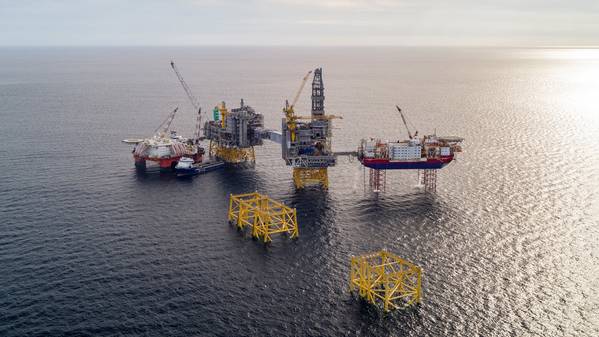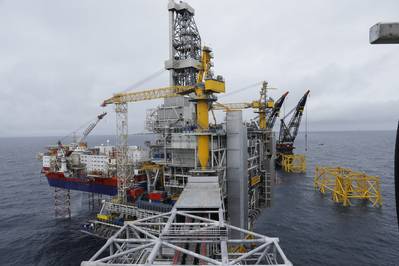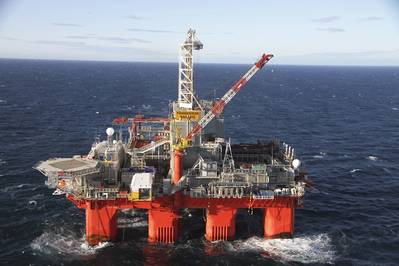
North Sea drilling activity this year could surpass 2017 levels while seeding a brighter 2019, as a range of indicators point to recovery after four years of rig glut and “cannibalization”.
Boldest among bellwethers is oil company spending. After campaigning since 2014 for lower supplier costs, blushing oil companies are starting to pay a little more to the fewer rigs around.
“There aren’t as many rigs as there used to be, but the supply overhang is not gone,” says ABG Sundal Collier rig-market analyst, Lukas Daul. He has seen first-hand the numbers behind recent rounds of mergers and bankruptcy in a drilling market Orbis Research puts at about $80 billion and says is heading toward $100 billion.
Daul says that while the overall rig-market’s day-rate health “depends where you look”, Norway and the U.K. seemed to be doing better. “In the North Sea, rates have rebounded for all assets. For modern ones and more standard ones. These have been a bright spot,” he says.
Norway this year has seen 26 exploration, appraisal and production wells drilled, or one more than for all of last year but several more than were drilled annually ahead of the oil price plummet of 2014. The U.K., at 90 wells so far this year, is four short of last year’s tally but on par with the heyday of the late 1960s. The U.K. sector of the North Sea has always seen more than four times the number of wells drilled than off of Norway, including the Barents Sea, the Norwegian Sea and the Norwegian sector of the North Sea, combined.
Leaner fleets
One of the causes of the market’s newfound buoyancy are the 160 to 170 rigs Daul says have been taken out of supply since the 2014 downturn. He cautions that there may be more rig culls to come. “But 2017 was the bottom, I would say, for the North Sea and maybe the shallow-water market. Depending on the asset class, harsh-environment has seen an uptick in day rates and there have been some incremental price increases on the jack-up side.”
Only the ultra-deepwater market, largely in the Gulf of Mexico and offshore Africa, has yet to see day rates recover, largely due to the allocation of capital among oil companies. In Norway, at least, some of that capital has come from long-time license owners recently turned operator.
One of those — there are several — is the Norwegian operation of Austrian OMV. OMV Norge now produces around 80,000 barrels of oil equivalent per day and has used the drill bit to prove 110,000 boe in Norway and, in 2018, to find gas and light oil at the Hades and Iris discoveries in the Norwegian Sea.
Better rigs
OMV and leading Norwegian rig patron, Equinor (formerly Statoil), may have begun paying a little more, but they’re employing rigs differently, and wells are being drilled simpler. “What might have happened is that some of the companies in light of this new capital approach are maybe drilling simpler wells. They’re not logging as much data as they used to in the expectation of lower drilling and overall costs. (Since) the scrapped rigs are the oldest rigs, the remaining rigs are younger and more capable, so there are drilling efficiencies that lower the number of offshore rigs you need. A rig can drill 12 wells instead of six, as before.”
For those counting strictly exploration wells, there are other good signs. Offshore giant, Equinor, is allotting about 70 percent of its upstream spend to the North Sea rim area: the Norwegian Continental Shelf and the U.K. Continental Shelf. While Equinor has cut exploration costs, it says the cuts to seismic surveys will open the way to maturing its discoveries by the drill bit.

(Photo: Arne Reidar Mortensen / Equinor)
Drill-bit spending
In addition, the 440,000-boepd Johan Sverdrup Phase 1 project is attracting billion-dollar module and jacket contracts (see Kvaerner) and drilling rigs. And Equinor and Lundin Petroleum (especially the latter) have also led the industry and its rigs to new discoveries in the Far North and in the U.K. sector, where Total’s large new Glenronach gas field has oil companies looking to hire rigs to delineate the trillion-cubic-meter gas find. Equinor, too, plans, three more exploration wells on the UKCS in 2019. In Norway, Equinor has spent an adjusted $340 million so far this year, or five percent over this interval last year, and this week added 25 million barrels with the “arctic” Skruis well, and at the end of October hired the Rowan Stavanger jack-up right through to 2025 for Gudrun drilling.
The uptick
So, with Brent holding at over $70 (and Equinor’s larger projects breaking even at under $15 a barrel), there’s an expectation that some rig demand could tighten some of that supply overhang.
The buoyant oil price also means offshore operators, as they have traditionally, will be keen to drill production wells, adding to the number of wildcats, appraisals and delineations in the works.
“If you look at the number of rigs working, you’ve seen jack-ups through last year and for a year-and-a-half increasing in number. Floaters bottoming out after several flat quarters — that’s likely to continue into ’19 as well, or probably somewhat up, but not massively. Now, there’s a lead time for offshore projects and then you’ll see some incremental (day-rate) price increases depending on the asset class and region.”
For today’s leaner rig fleets, those are welcome morsels of news. Though a far cry from the $550,000 day rates seen five years ago, Transocean and others are reporting slightly higher rates.
The newbuild, hars-environment semi-submersible drill rig Transocean Norge has a new, six-well contract with Equinor in Norway that’ll see the rig earn $10,000 more a day (for $293,000).
The Transocean Spitsbergen will earn $60,000 more when drilling its one-well option for the same oil company.

(Photo: Equinor)